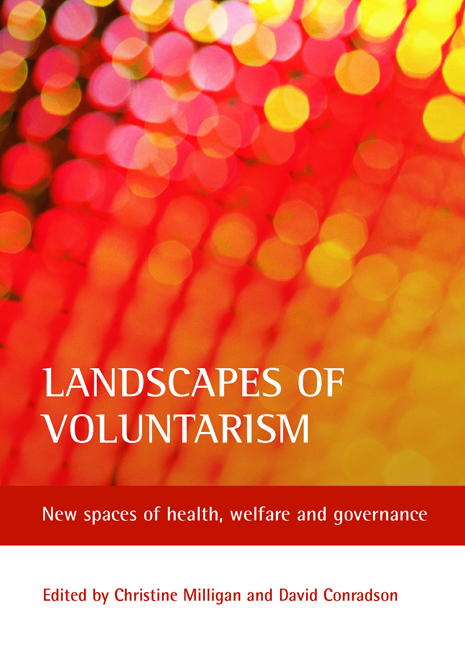Book contents
- Frontmatter
- Contents
- List of tables, figures, maps and plates
- Notes on contributors
- Foreword: Beyond the shadow state?
- one Contemporary landscapes of welfare: the ‘voluntary turn’?
- two A ‘new institutional fix’? The ‘community turn’ and the changing role of the voluntary sector
- three Renewal or relocation? Social welfare, voluntarism and the city
- four Voluntarism and new forms of governance in rural communities
- five New times, new relationships: mental health, primary care and public health in New Zealand
- six Informal and voluntary care in Canada: caught in the Act?
- seven Competition, adaptation and resistance: (re)forming health organisations in New Zealand’s third sector
- eight The difference of voluntarism: the place of voluntary sector care homes for older Jewish people in the United Kingdom
- nine Values, practices and strategic divestment: Christian social service organisations in New Zealand
- ten Faith-based organisations and welfare provision in Northern Ireland and North America: whose agenda?
- eleven Government restructuring and settlement agencies in Vancouver: bringing advocacy back in
- twelve Developing voluntary community spaces and Ethnicity in Sydney, Australia
- thirteen The voluntary spaces of charity shops: workplaces or domestic spaces?
- fourteen The changing landscape of voluntary sector counselling in Scotland
- fifteen Volunteering, geography and welfare: a multilevel investigation of geographical variations in voluntary action
- sixteen Reflections on landscapes of voluntarism
- Index
three - Renewal or relocation? Social welfare, voluntarism and the city
Published online by Cambridge University Press: 15 January 2022
- Frontmatter
- Contents
- List of tables, figures, maps and plates
- Notes on contributors
- Foreword: Beyond the shadow state?
- one Contemporary landscapes of welfare: the ‘voluntary turn’?
- two A ‘new institutional fix’? The ‘community turn’ and the changing role of the voluntary sector
- three Renewal or relocation? Social welfare, voluntarism and the city
- four Voluntarism and new forms of governance in rural communities
- five New times, new relationships: mental health, primary care and public health in New Zealand
- six Informal and voluntary care in Canada: caught in the Act?
- seven Competition, adaptation and resistance: (re)forming health organisations in New Zealand’s third sector
- eight The difference of voluntarism: the place of voluntary sector care homes for older Jewish people in the United Kingdom
- nine Values, practices and strategic divestment: Christian social service organisations in New Zealand
- ten Faith-based organisations and welfare provision in Northern Ireland and North America: whose agenda?
- eleven Government restructuring and settlement agencies in Vancouver: bringing advocacy back in
- twelve Developing voluntary community spaces and Ethnicity in Sydney, Australia
- thirteen The voluntary spaces of charity shops: workplaces or domestic spaces?
- fourteen The changing landscape of voluntary sector counselling in Scotland
- fifteen Volunteering, geography and welfare: a multilevel investigation of geographical variations in voluntary action
- sixteen Reflections on landscapes of voluntarism
- Index
Summary
Voluntarism in the contemporary UK policy landscape
Since its election to power in 1997, the UK Labour government has played a significant role in raising the profile of the voluntary sector within national policy discourse. As Wrigglesworth and Kendall observe, ‘From being a shadow enclave at the periphery of the mental map of policy makers and shapers the [voluntary] sector has increasingly occupied centre stage in their minds’ (2000, p 1). Addressing an audience of voluntary organisation representatives in 2004, Labour's Chancellor of the Exchequer, Gordon Brown, declared that since the 1990s there has been ‘a quiet revolution in how voluntary action and charitable work serves the community’ (www.ncvo-vol.org.uk). This ‘quiet revolution’ has its roots in the policies of the Conservative governments in the 1980s and 1990s. Articulating arguments advanced by many on the political right, the Conservatives championed the third sector as an antidote to an unresponsive, bureaucratic welfare state that stifled choice and community initiative. As a result, voluntary organisations have come to play increasingly important roles in areas such as local community development, health and social services, ‘often in contractual relationships [with government] through which they received substantial sums of money’ (Plowden, 2003, p 416).
The momentum behind developing the role and responsibilities of the third sector in UK society has significantly increased from the late 1990s as part of Labour's programme of welfare reforms (Powell, 1999; Clarke et al, 2000). The ideological and political foundations of this interest lie with the interplay between neoliberalism and neocommunitarianism that has characterised the development of Labour policy. Keen to distance itself from both the ‘Old’ Labour Left (pro-state, anti-market) and the Thatcherite Right (pro-market and anti-state); ‘New’ Labour has embraced the political philosophy of the ‘third way’ (Giddens, 1998). While this contains a neoliberal emphasis on the need to engage with the new ‘realities’ of globalisation and embrace the market, choice and competition, it also adopts a neocommunitarian stance by stressing the strategic importance of civil society for social cohesion and economic vitality. This neocommunitarian emphasis on civil society has been crucial not only to providing Labour with the type of ‘post-Thatcherite edge it wants’ (Driver and Martell, 1997, p 36) but also to promoting the role of the third sector within Labour policy discourse.
- Type
- Chapter
- Information
- Landscapes of VoluntarismNew Spaces of Health, Welfare and Governance, pp. 33 - 52Publisher: Bristol University PressPrint publication year: 2006

